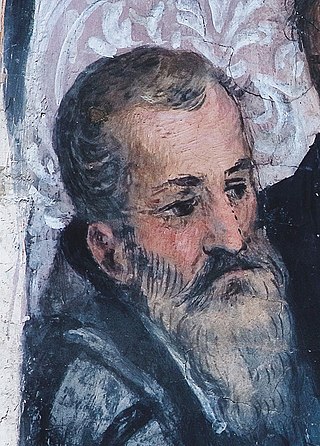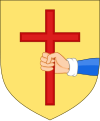
Hugh O'Neill, Earl of Tyrone was a Gaelic Irish lord and key figure of the Nine Years' War. Known as the "Great Earl", he led the confederacy of Irish clans against the English Crown in resistance to the Tudor conquest of Ireland under Queen Elizabeth I.
Niall Garve O'Donnell was an Irish nobleman and soldier who claimed the lordship of Tyrconnell, alternately a rebel against and ally of English rule in Ireland. He is best known for siding with the English against his kinsman Hugh Roe O'Donnell during the Nine Years' War.
Manus O'Donnell was a Gaelic Irish lord and King of Tyrconnell. After his father Hugh Dubh's death in 1537, Manus succeeded as Tyrconnell's ruler. In 1555 he was imprisoned and deposed by his son Calvagh, who effectively took over the kingdom's leadership. Manus died during his imprisonment in Lifford.

The Flight of the Earls took place in September 1607, when Hugh O'Neill, Earl of Tyrone, and Rory O'Donnell, 1st Earl of Tyrconnell, and about ninety followers, left Ulster in Ireland for mainland Europe. Their permanent exile was a watershed event in Irish history, symbolizing the end of the old Gaelic order.

Rory O'Donnell, 1st Earl of Tyrconnell, was an Irish Gaelic lord and the last King of Tyrconnell prior to the Plantation of Ulster. He succeeded his older brother Hugh Roe O'Donnell and in 1603 became the first to be styled the Earl of Tyrconnell. In 1607, following their defeat in the Nine Years' War, Tyrconnell and his wartime ally Hugh O'Neill, Earl of Tyrone, fled Ireland for mainland Europe. Tyrconnell died of a fever shortly after settling in Rome.

Hugh Roe O'Donnell II, also known as Red Hugh O'Donnell, was an Irish clan chief, Lord of Tyrconnell, and senior leader of the Irish confederacy during the Nine Years' War.

Hugh Albert O'Donnell, 2nd Earl of Tyrconnell was an Irish nobleman descended from the O'Donnell clan of Tyrconnell. He was the only son of Rory O'Donnell, 1st Earl of Tyrconnell, whose title was posthumously attainted in 1614. In adult life, Hugh Albert used the style Earl of Tyrconnell, Baron of Donegal and Lifford, Lord of Sligo and Lower Connaught, and Knight Commander of the Order of Alcántara. He is sometimes considered to be the last King of Tyrconnell, though he left Tyrconnell as an infant never to return.

Lady Fiona MacDonald was a Scottish aristocrat and queen consort of Tyrconnell. She is better known by her nickname Iníon Dubh, pronounced in Ulster Irish and Scots Gaelic as in-NEEN DOO.
Sir Eoin McToole O'Gallagher was a Gaelic Irish political advisor during the Elizabethan era. He was head of the O'Gallagher family and the chief advisor to the O'Donnell dynasty who ruled Tyrconnell. He was the son of Tuathal Balbh O'Gallagher. He came to prominence during the rule of Sir Hugh O'Donnell. His good relationship with the Crown is shown by his being awarded an annual pension in 1574 and a knighthood in 1581.
Sir Donal Dubh O'Donnell was a member of the O'Donnell dynasty of Tyrconnell in modern-day County Donegal. He was the eldest son of Sir Hugh McManus O'Donnell, the Lord of Tyrconnell for much of the reign of Elizabeth I.
Hugh McHugh Dubh O'Donnell was a member of the O'Donnell dynasty of Tyrconnell in modern-day County Donegal. He was the younger brother of Manus O'Donnell, the ruler of Tyrconnell between 1537 and 1555. When his brother died, Hugh Dubh unsuccessfully challenged for the lordship, which was held by his two nephews, Calvagh O'Donnell and Sir Hugh O'Donnell. He was supported in his claim by Miler Magrath who suggested that his seniority in the family made him the rightful candidate.

Cathbarr O'Donnell was an Irish nobleman and member of the O'Donnell dynasty of Tyrconnell. The youngest brother of Red Hugh O'Donnell, Cathbarr fought in the Nine Years' War. He married Rosa O'Doherty, sister of Cahir O'Doherty.
Nuala O'Donnell was an Irish noblewoman of the O'Donnell dynasty who took part in the Flight of the Earls. She was known as "the Lady of the Piercing Wail".
Siobhán O'Neill, Countess of Tyrone, sometimes anglicised Joanna, Joan, or Judith, was a sixteenth-century Irish Gaelic noblewoman of the O'Donnell clan. She was the second wife of Hugh O'Neill, Earl of Tyrone, bearing him most of his children.
Henry Hovenden was an Anglo-Irish secretary and lawyer. He was foster-brother and chief advisor to Hugh O'Neill, Earl of Tyrone during the Irish Nine Years' War.
Rose O'Neill was a Gaelic Irish noblewoman and queen consort of Tyrconnell. She was the daughter of Hugh O'Neill and wife of "Red" Hugh Roe O'Donnell, the two leaders of the Irish confederacy during the Nine Years' War. Her marriage to O'Donnell was a deliberate move to unite the O'Neills and the O'Donnells, the two most powerful Irish clans of their day. She separated from O'Donnell in 1595 and their marriage formally ended the following year.
Manus O'Donnell was an Irish nobleman and member of the O'Donnell dynasty.
Hugh MacEdegany,, also known as Hugh MacCalvagh, and referred to as Hugh O'Gallagher by modern historians, was a sixteenth-century Irishman who was a challenger to the Gaelic kingdom Tyrconnell.
Siobhán Maguire was a Gaelic Irish noblewoman, perhaps best known as the biological mother of Hugh O'Neill, Earl of Tyrone.









